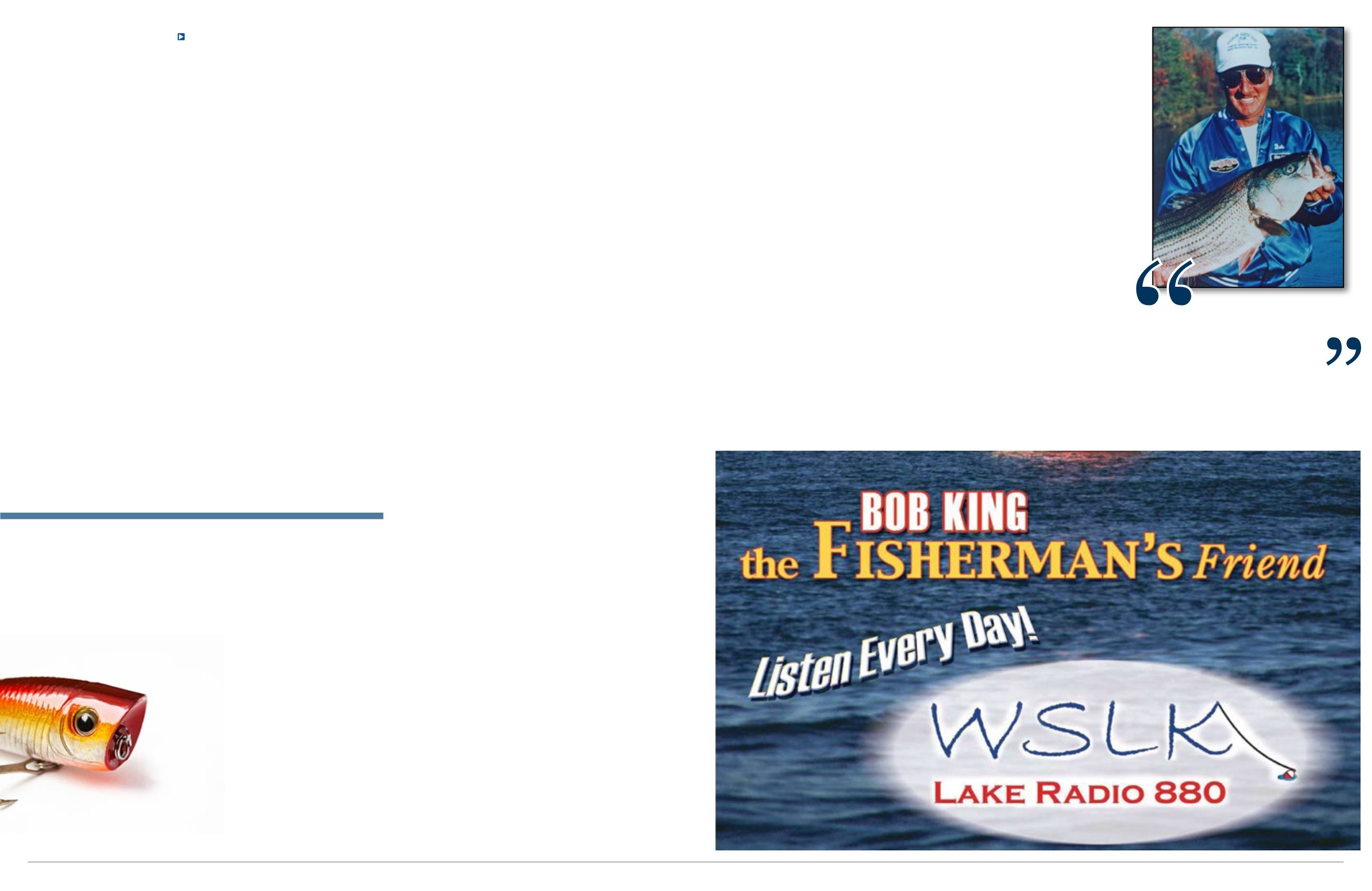
Discover Smith Mountain Lake
WINTER 2015/16
23
22
Bass.
After I learned this information, I tried fishing the same as I would in saltwater, with little
success. I studied the fish and the forage, and the characteristics of the lake, to learn how to
finally be able to catch these fish. This did not happen overnight; it took a lot of work, and
many trials and errors, but I did it.
Friends and relatives would visit, and of course I would take them fishing. They were amazed
at how good the fishing is on this lake. They were typically impressed with our bass catches.
It took me quite a while to learn to catch bass here, because this lake is unlike any other that
I had fished. Because of the vast surface area of the lake, the shore line configuration, local
geography, and the water depth, this lake is called a Highland lake .
After a while, when others saw the catches we were getting, they would call and ask me to
take them fishing. It wasn’t long before people started offering to pay, but at first, I only took
gas money. Eventually, I started a part-time guide service for Bass and Stripers. It finally
went to full time, and I fished mainly for Stripers. At one point, a striper fishing club was
started, of which I later became President. I served for about 10 years, during which time I
worked with VADGIF and aided with stocking, rules, and regulations until I was too busy and
retired from that post.
After that, I discovered how much the moon affected the all fish and other wildlife, and began
adding this information to my articles. I later helped some people that wanted to be fishing
guide, helping them to get their USCG Captain’s Licenses. I helped the Coast Guard to design
a specific test for Captains working only in SML. Because of the popularity of the lake, I and
4 other business people tried to change the name of Moneta to “Smith Mountain Lake”, so
that we would have an identity. When that failed to come to fruition, we started the SML
Chamber of Commerce.
Fishing for bass during late fall and winter months can be daunting. During the regular
season, you have identifiable structures to fish. Vegetation and the sun offer shaded areas,
which will produce fish in the heat of the day. Winter, however, does not give you any of
those visible signs.
So what do we do? Now we need to fish on the points, over structure and trees at depths you
locate with your fish finder. These are usually found in winter about 30 feet down.
Jigging a jig, a spoon , or a soft plastic worm should do well for you, and don’t be afraid to
use a larger plastic worm: jigging or slow crawling it on the bottom, or even dead sticking the
worm, shaking the rod tip on occasion. The water is much colder in winter. Everything has
slowed down; therefore, so should your fishing, if you want to make your time productive.
Smith Mountain Lake is a good place to fish at steep drop-offs with a worm, a jig, or a spinner
bait. A fish scent works well in combination with the soft plastic worms. Live bait also works
well. Remember: the key to success in any winter fishing is patience.
Fish for Walleye by jigging on the points. They like low light situations, and here again, the
water is cold, so taking it slowly is the key. Jigging a soft bait or spoon, such as a Hopkins,
also works very well.
Stripers can be caught in the early morning hours, just as the first light of the day starts to
show in the sky. Keep your lights from reflecting off of the water, and fish in the coves. Pick
Good Luck &
Take a kid fishin’!
BOB KING
Questions? Send me an e-mail!
a spot where you can see a lot of dots on your graph. As the sky begans to
get a little lighter, you will see bubbles rising to the surface. Cast a 5” or 6”
plastic minnow (Redfin, Rebel, Long-A or Thunder Stick) toward the bubbles.
Then holding your rod tip down, retrieve very slowly, keeping the lure on the
surface, and wait for the strike. This is a great time to catch a trophy.
Once the sunlight establishes itself pretty well on the surface of the water,
the fish and bait will go to the deep water in the channel, at about 35 feet
deep. That’s when you will want to switch over to jigging and trolling.
When I troll for Stripers, I prefer to use lead core line. It is easier to get the
lure down to the desired depth, and that should be right above the school
of fish that you see on your graph. Again, troll as slowly as you can, and be
mindful of the tree tops. It is much easier to go over tree tops with lead core
line when pulling jigs and spoons. It is more difficult to pull lines up when
fishing plastic lines pulling crank baits.
Usually, when fishing before daylight like this, I go to breakfast when the sun
comes up, since by that time I usually have caught my limit. Some folks might
be less inclined to navigate the lake in the dark. By all means, if you don’t feel
comfortable traveling the lake before daylight, start later and troll or jig in
daylight. You can still have great success if you know what to do.
As always fish by the moon phases…
WINTER TIPS


